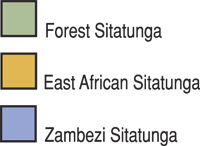 |
 |
Tragelaphus spekei gratus
DESCRIPTION Basic coloration in the male varies from grayish brown to chocolate brown, with much variation in the white markings. Some individuals will exhibit the full complement of white facial markings, vertical white body stripes, white dorsal stripe, white neck bands, and white spots on the hips, while others will show little or no white except on the face, and others will have intermediate characteristics. The female is reddish to reddish brown. The coat is shorter than in other sitatunga subspecies.
DISTRIBUTION Fragmented populations of forest sitatunga may still be found in suitable habitat in parts of Senegal, Gambia, Guinea-Bisseau, possibly Guinea, northern Sierra Leone, southwestern Ivory Coast, southeastern Ghana, southern Togo, southern Benin, and southern Nigeria. They are widespread in southern Cameroon, Equatorial Guinea, Gabon, Congo (B), southern Central African Republic, and nearly all of Congo (K). They also occur in extreme southwestern Sudan on the Congo (K) border and in the northeastern corner of Angola bordering Congo (K). The main population is centered in the Congo River basin.
In addition, an isolated population is found along the southern and eastern shores of Lake Chad in northeastern Nigeria, northern Cameroon and western Chad. Another isolated population of what is believed to be western sitatunga may still occur in north-central Angola.
TAXONOMIC NOTES The SCI forest sitatunga category includes the former western sitatunga. Some authorities treat the forest sitatunga (larkeni) and western sitatunga (gratus) as separate subspecies, but we combine them because we are unable to tell them apart in the field or draw a boundary to separate them. We prefer "forest sitatunga" as the more meaningful common name, and use the subspecific name gratus Sclater, 1880 because it has priority.
|





